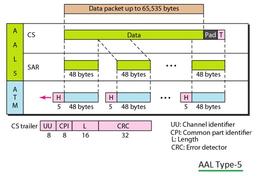Understanding ATM Service Categories: CBR, VBR, ABR, UBR, and GFR
Advertisement
Asynchronous Transfer Mode (ATM) offers various service categories to accommodate different types of data traffic. These include Constant Bit Rate (CBR), Variable Bit Rate (VBR), Available Bit Rate (ABR), Unspecified Bit Rate (UBR), and Guaranteed Frame Rate (GFR). Each category is designed to meet specific network demands, such as bandwidth allocation and delay sensitivity. In this article, we explore the unique characteristics of each ATM service category and highlight the key differences between them to help you understand how ATM networks manage diverse data flows efficiently.
As we know, ATM networks are developed to take care of transportation of different kinds of traffic such as voice, video, and data. These different forms of information are transmitted in the form of ATM cells. The ATM cells are handled based on characteristics of traffic flow needed and applications of use in the network. Broadly, ATM services are categorized into real-time services and non-real-time services. Real-time services include CBR and rt-VBR. Non-real-time services include nrt-VBR, ABR, and UBR.
Figure depicts percent of line capacity with respect to time for all the ATM services.

ATM CBR: Constant Bit Rate
- Used for applications requiring a fixed data rate available always during the lifetime of the connection.
- Used for applications requiring a stringent transfer delay upper limit.
- Used for uncompressed video and audio.
- APPLICATIONS: Telephony, Videoconferencing, Audio and Video distribution and retrieval etc.
ATM rt-VBR: Real-time Variable Bit Rate
- Used for applications requiring a tight limit on delay i.e., used for time-sensitive applications.
- It allows more flexibility to the network compared to CBR.
- APPLICATIONS: LIVE TV Transmission having video information
ATM nrt-VBR: Non-Real-Time Variable Bit Rate
- Used for applications which do not have a tight limit on delay.
- Used for bursty nature of traffic.
- It is used for applications requiring critical time response limits during data transfer.
- APPLICATIONS: bank transactions, airline reservations, railway reservations etc.
ATM UBR: Unspecified Bit Rate
- At any moment in time, some amount of capacity in the ATM network is utilized by CBR and VBR type of traffics. The left over unused capacity is made available for UBR applications.
- Used for applications which can tolerate ATM cell losses as well as variable delays, for example TCP based traffic.
- EXAMPLES:
- Remote terminal access applications
- Used for text/image transfer, messaging, retrieval, and distribution applications
ATM ABR: Available Bit Rate
- It is used to improve services of bursty sources serviced by UBR.
- Applications utilizing ABR services will specify PCR (Peak Cell Rate) and MCR (Minimum Cell Rate) for the applications.
- The remaining part of capacity not utilized by ABR is available for UBR type of traffic.
- EXAMPLE: LAN to LAN connection for information transfer
ATM GFR: Guaranteed Frame Rate
- Used for non-real-time applications which guarantee a minimum rate guarantee.
- MCR is guaranteed by network, the rest up to MCR is delivered on a best effort basis.
Difference between CBR, VBR, ABR, UBR, and GFR
| Service category | CBR | VBR | ABR | UBR | GFR |
|---|---|---|---|---|---|
| Full form | Constant Bit Rate | Variable Bit Rate | Available Bit Rate | Unspecified Bit Rate | Guaranteed Frame Rate |
| Description | Provides a fixed bandwidth at a constant rate, ideal for real-time traffic. | Offers a flexible bit rate that varies based on the needs of the application. Comes in two types: real-time (rt-VBR) and non-real-time (nrt-VBR). | Adjusts to the available network bandwidth; provides feedback control to ensure traffic flow according to network conditions. | Does not guarantee any specific QoS; traffic is sent whenever bandwidth is available. | Ensures a minimum frame rate with the ability to handle bursts of traffic. |
| Traffic Type | Real-time, delay-sensitive (e.g., voice, video) | Variable, bursty traffic (e.g., video streaming) | Elastic traffic (e.g., data transfer) | Best-effort, non-sensitive data | Frame-based traffic, like LAN traffic |
| QoS Guarantee | High guarantee (fixed delay, low jitter) | Real-time: Low delay; Non-real-time: Less strict QoS | No fixed guarantee, but minimum rate is ensured | No guarantee | Guarantees minimum throughput |
| Bandwidth Allocation | Predefined and constant | Dynamic but controlled | Variable, depending on network capacity | No predefined rate | Dynamic with minimum guarantee |
| Typical Use cases | Voice calls, video conferencing | Video streaming, interactive applications | File transfers, LAN/WAN interconnectivity | Email, web browsing, general data transfer | Frame-based traffic, such as IP and Ethernet frames |
Conclusion
ATM service categories, including CBR, VBR, ABR, UBR, and GFR, offer flexible solutions for handling various types of data traffic. Each service class is tailored to different network needs, whether for real-time applications or general data transfer. Understanding the differences between these categories is essential for optimizing network performance and ensuring efficient data transmission in ATM networks.
Advertisement
 RF
RF


